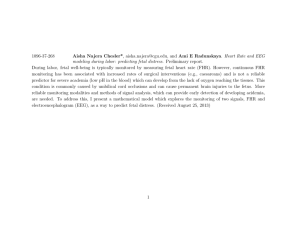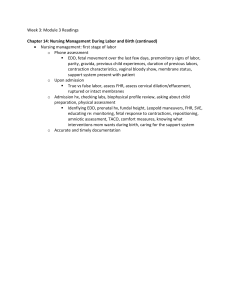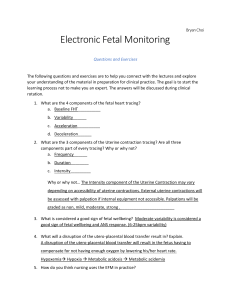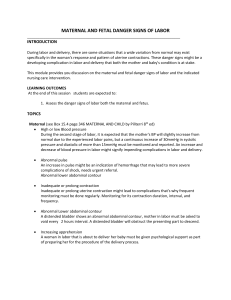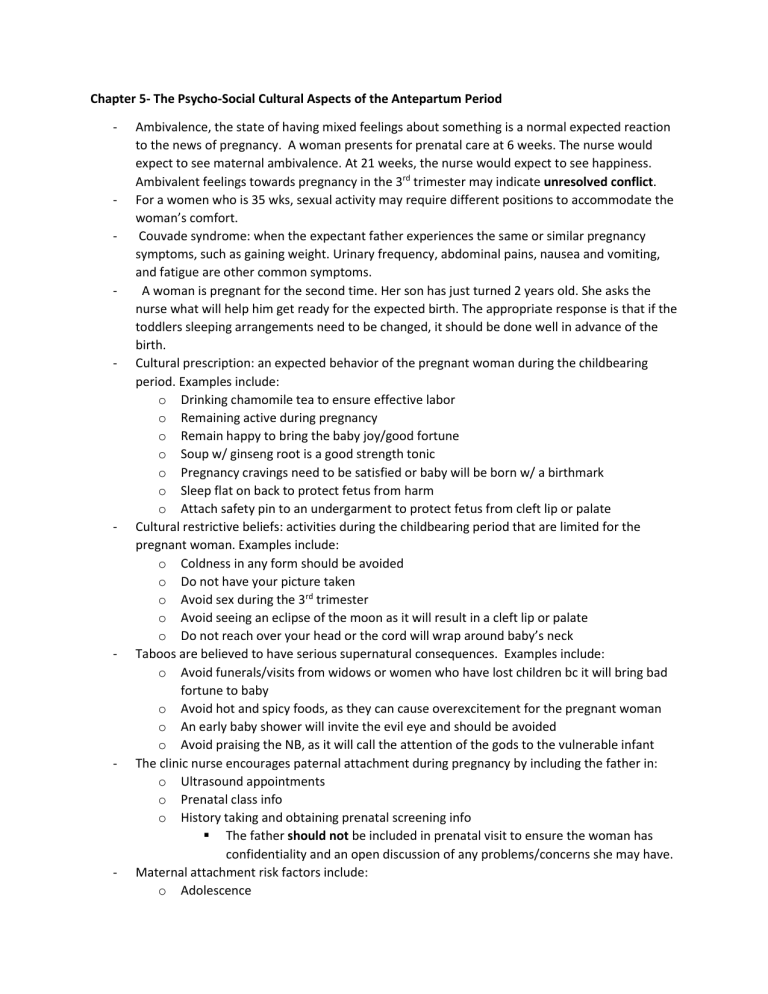
Chapter 5- The Psycho-Social Cultural Aspects of the Antepartum Period - - - - - - - - Ambivalence, the state of having mixed feelings about something is a normal expected reaction to the news of pregnancy. A woman presents for prenatal care at 6 weeks. The nurse would expect to see maternal ambivalence. At 21 weeks, the nurse would expect to see happiness. Ambivalent feelings towards pregnancy in the 3rd trimester may indicate unresolved conflict. For a women who is 35 wks, sexual activity may require different positions to accommodate the woman’s comfort. Couvade syndrome: when the expectant father experiences the same or similar pregnancy symptoms, such as gaining weight. Urinary frequency, abdominal pains, nausea and vomiting, and fatigue are other common symptoms. A woman is pregnant for the second time. Her son has just turned 2 years old. She asks the nurse what will help him get ready for the expected birth. The appropriate response is that if the toddlers sleeping arrangements need to be changed, it should be done well in advance of the birth. Cultural prescription: an expected behavior of the pregnant woman during the childbearing period. Examples include: o Drinking chamomile tea to ensure effective labor o Remaining active during pregnancy o Remain happy to bring the baby joy/good fortune o Soup w/ ginseng root is a good strength tonic o Pregnancy cravings need to be satisfied or baby will be born w/ a birthmark o Sleep flat on back to protect fetus from harm o Attach safety pin to an undergarment to protect fetus from cleft lip or palate Cultural restrictive beliefs: activities during the childbearing period that are limited for the pregnant woman. Examples include: o Coldness in any form should be avoided o Do not have your picture taken o Avoid sex during the 3rd trimester o Avoid seeing an eclipse of the moon as it will result in a cleft lip or palate o Do not reach over your head or the cord will wrap around baby’s neck Taboos are believed to have serious supernatural consequences. Examples include: o Avoid funerals/visits from widows or women who have lost children bc it will bring bad fortune to baby o Avoid hot and spicy foods, as they can cause overexcitement for the pregnant woman o An early baby shower will invite the evil eye and should be avoided o Avoid praising the NB, as it will call the attention of the gods to the vulnerable infant The clinic nurse encourages paternal attachment during pregnancy by including the father in: o Ultrasound appointments o Prenatal class info o History taking and obtaining prenatal screening info The father should not be included in prenatal visit to ensure the woman has confidentiality and an open discussion of any problems/concerns she may have. Maternal attachment risk factors include: o Adolescence - - - o Low educational level o History of depression Signs of possible maladaptation to pregnancy include a denial of fears about childbirth and unrealistic expectations about birth. Measurable outcomes of social support interventions during pregnancy include improved coping and functional status. When conducting a psychosocial assessment, it is important to determine the frequency, duration, and intensity of mood or emotional disturbances. To facilitate adaptation to pregnancy during the 1st trimester, an appropriate response would be to assess the woman’s response to pregnancy. Paternal developmental tasks: o Announcement phase: men may react to the news of pregnancy with joy, distress, or a combo of emotions, depending on whether it was planned or unwanted. May last from a few hours-several weeks. o Moratorium phase: when many expectant fathers appear to put conscious thought of their partner’s pregnancy aside, even as their partners are undergoing dramatic physical and emotional changes before their eyes. Feelings of rivalry may surface as the fetus grows larger and the woman becomes more preoccupied with her own thoughts. o Focusing phase: begins in the last trimester. Men will eb actively involved in pregnancy and their relationship w/ the child. Factors that influence maternal adaptation: o Multiparity o Maternal age: adolescent and older mothers o Lesbian mothers o Single parenting o Multigestational pregnancy: twins, triplets, etc. o Socioeconomic factors o The abused woman: pregnancy is often a trigger for beginning or increased abuse or IPV. It often gets worse during pregnancy. o Military deployment Family structures: o Nuclear: father, mother, and child o Extended: three generations o Single-parent: divorced, never married, separated, or widowed man or woman w/ at least one child o Dyad: couple living alone without children o Stepparent: one or both spouses have remarried into a family w/ at least one child o Blended or reconstituted: combo of two families w/ children from one or both families o Cohabitating: unmarried couple living together o Gay or lesbian: couples who have at least one child Chapter 9- Fetal Heart Rate Assessment https://quizlet.com/287022705/online-questions-chapter-15-fetal-assessment-during-labor-nclexflash-cards/ - - - - - Category I fetal heart rate: baseline rate of 150 bpm (within 110-160), moderate variability (normal), and accelerations show well-oxygenation. Category II fetal heart rate: indeterminate, not necessarily normal or abnormal. Minimal variability, absent variability but no decels, no acceleration after fetal stimulation. The nurse should assist the laboring woman to a left lateral position. Category III fetal heart rate: abnormal. Absent or minimal variability with decelerations. Normal contraction for labor: roughly 3-5 per 10 minutes, lasting at least 30 seconds each Maternal position changes maximize uterine blood flow. Intrauterine pressure catheter (IUPC) is a device placed into the amniotic space during labor to measure frequency, duration, intensity, and resting tone of contractions. To measure intensity, subtract the baseline from the peak pressure (mm Hg) Fetal HR should be assessed in a low risk woman in active labor every 30 minutes. Variability: how the heart rate changes from second to second. Should see fluctuations by 6-25 bpm around the baseline. Indicates the baby has a healthy nervous system. Absent variability: undetectable amplitude Minimal variability: amplitude equal to or less than 5bpm. Decreased variability is associated with fetal hypoxia, acidemia, and tachycardia. Moderate variability: amplitude is 6-25 bpm (normal) Marked variability: amplitude greater than 25 bpm Intensity of contraction: palpation o Mild 1+: tip of nose (easily indented) o Moderate 2+: chin (can slightly indent) o Strong 3+: like forehead (can not indent) Tocodynamometer: external uterine device monitor that measures frequency and duration of UC, cannot measure intensity or pressure. External fetal heart monitor: measures FHR and uterine pressure The spiral electrode placed internally can monitor accelerations of the fetal HR. Resting tone./baseline pressure: pressure in uterus between UC. Should be between 5-25 Frequency of contractions: count number of contractions in 10 minutes. Start at 1 contraction to the start of the next (minutes). o Normal UC: 5 or fewer in 10 minutes averaged over 30 minutes o Tachysystole/Hyper-stimulation: greater than 5 UC in 10 minutes over 30 minute window Periodic changes: accelerations or decelerations that are in relation to UC - - - - - - Episodic changes: accelerations or decelerations that are not associated with UC. Accelerations are mostly episodic. Acceleration: good sign that fetus is well oxygenated and moving around. Increase in HR by at least 15 bpm, for at least 15 seconds, no longer than 2 minutes. No medical management required. Deceleration: drop in FH of more than 15 bpm, with an onset to nadir (lowest FH recorded) of more than 30 secs duration. o Early decel: mirrors a contraction, no intervention needed, result of head compression. Contraction is causing babies head to be squeezed. o Late decel: not a mirror image of the contraction. Starts after the contraction and ends after the contraction. Main cause is uteroplacental insufficiency (decreased blood flow less oxygen to fetus). Interventions: “LIONS”: left lying position, IV fluids, oxygen, notify provider, prep for surgery. o Variable decel: abrupt decrease, sharp dramatic drop (resembles a “V”) during various phases of the contraction. There’s no real pattern. Occasional variable decels are normal. Cause is umbilical cord compression. Intervention: put Mom in Trendelenburg position, knee chest position, oxygen therapy, discontinue oxytocin, notify MD. Amnioinfusion may be indicated if caused by oligohydramnios. “VEAL CHOP” pneumonic for acels + decels o Variable cord compression o Early head compression o Accelerations OK o Late Placenta problem Prolonged decel: abrupt decrease greater than 15 bpm, lasting longer than 2 minutes and less than 10 minutes Bradycardia: less than 110 bpm, must be sustained for more than 10 minutes. o Normal: fetal sleep o Maternal factors: supine positioning, hypotension, hypoglycemia o Maternal-fetal interface: prolonged cord compression, umbilical cord prolapse, poor uterine profusion o Fetal factors: arrythmia, vagal stimulation o Medications: opioids, anesthesia, magnesium sulfate, beta blockers o Interventions: side lying position, IV fluids, & oxygen, notify the provider. Tachycardia: above 160 bpm, must be sustained for more than 10 minutes. o Normal: fetal movement/stimulation o Maternal factors: stress/anxiety, fever/infection, thyrotoxicosis, anemia, hypoxia o Maternal-fetal interface: chorioamnionitis, abruptio placentae o Fetal factors: arrythmias, anemia/acute blood loss o Medications: anticholinergics, sympathomimetics, illicit drugs o Causes include maternal fever or infection, fetal hypoxia, maternal hyperthyroidism, cocaine use. Interventions: antipyretic for fever, IV fluids, oxygen. When heart rate goes up but variability goes down, it’s a bad sign. Duration of contractions: beginning to end of 1 UC (seconds) Intensity: strength of contraction with IUPC or measured by palpation - - - The nurse’s responsibility related to EFM is to teach the woman and her family about monitoring equipment and discuss any questions they have. A nurse is preparing to monitor a pt who is to receive an amnioinfusion. Which actions should the nurse make this time? Assist in insertion of an internal uterine pressure catheter (IUPC). A fetal scalp stimulation technique to assess the fetal scalp pH is used when the fetal HR is within the baseline. When using intermittent auscultation to assess uterine activity, nurses should be aware that the examiner’s hand should be placed over the fundus, before, during, and after contractions. While assessing the FHR with a fetoscope, the nurse palpates the abdomen of the fetus to evaluate UCs. This detects any changes in the FHR during and after UCs. Terbutaline (Brethine) is prescribed to postpone labor, because he drug reduce the frequency of UCs. It can also increase the FHR. The nurse is assisting a woman in labor. The instructions she gives to the patient to promote comfort include breathing with mouth open, lying down in the lateral position, and lying in the semi-fowler’s position. While monitoring the FHR, the nurse instructs the patient to change positions and lie in the knee-to-chest position. What is the reason for the nurse to give this instruction to the patient? Variable decelerations in the FHR. The knee-to-chest position is useful for relieving cord compression. For a patient who has received general anethesia, the nurse should observe for minimal variability in FHR. Lactated Ringer’s or normal saline is given into the umbilical cord to increase the amniotic fluid volume and normalize FHR activity. Secobarbital (Seconal) is a drug that can cause minimal variability. Prolonged decels are usually isolated events that end spontaneously. Increasing the infusion rate of nonadditive IV fluids can increase fetal oxygenation by expanding maternal blood volume Maternal hypotension can result in uteroplacental insufficiency. To determine fetal lactate levels, the fetal blood is collected by making a small incision on the fetal scalp. The FHR should be auscultated before and after ambulation and rupture of membranes. Normal contractions occur every 2-5 minutes and last less than 90 seconds. The most common cause of decreased variability in he fetal HR hat lasts 30 minutes or less is fetal sleep cycles. A FHR that is tachycardic, is bradycardic, or has late decels or loss of variability is nonreassuring and is associated with hypoxemia. The three measures the nurse should implement to provide intrauterine resuscitation is to reposition the mother, increase IV fluid and provide oxygen via face mask. Prior to obtaining an ECG of the fetus, the nurse should assess placental membranes and cervical dilation. A late deceleration is likely caused by placental abruption and maternal supine hypotension. Continuous electronic fetal monitoring is used when oxytocin is given due to uteroplacental exchange may be compromised. - The nurse is assessing a pregnant patient through a TOCO placed externally and a spiral electrode placed internally. What info would the nurse obtain by this arrangement? Duration of the UC, frequency of UC, and accelerations of FHR Chapter 11- Intrapartum and Postpartum Care of Cesarean Birth Families - - A nurse caring for a woman who is 4 hrs post C/S for arrest of labor. The records indicate that she has premature ROM followed by 36 hrs of labor. Her IV fluid intake for the past 24 hrs is 2500 mL. the estimated blood loss is 1500 mL. based on this data, the woman is at risk for? o Fluid volume deficit o Infection o Impaired mother-infant attachment o Falls - Deep breathing following a C/S is critical for the prevention of pneumonia and atelectasis (lung collapse). - Normal platelet count is 150,000-400,000. Low count places woman at risk for bleeding. - Normal hemoglobin is 11.5-13.0 g/dl - In a client with paralytic ileus(when the muscle contractions that move through your intestines are temporarily paralyzed), the nurse would expect to see abdominal distention. - The perinatal nurse is preparing a woman for a scheduled C/S. the woman will be receiving spinal anesthesia for the birth. In order to prevent maternal hypotension, the nurse will administer a rapid IV infusion of 500 mL of NS. An IC fluid preload of 500-1,00 mL is given before administering a spinal or epidural anesthesia to increase fluid volume and decrease risk of hypotension r/t effects of anesthetic agent. - Combining an opioid with a local anesthetic preserves a greater amount of maternal motor function because it reduces the total amount of anesthetic required. The best time to give prophylactic antibiotics to the women undergoing C/S is one hour before the surgery. The best intervention to help maintain maternal normothermia in the OR is to provide warm blankets, warmed IV fluids and maintain the temperature in the OR. Pain management is the responsibility of the nurse, anesthesia provider, and the primary physician. A common indication for a surgical birth is fetal intolerance of labor. The major maternal medical indications for a C/S are: o Previous C/S o Placental abnormalities o Mechanical impediment of the progress of labor or arrest of active labor o Cephalopelvic disproportion, which occurs when ineffective contractions lead to prolonged first stage of labor or when the size, shape, or position of the fetal head prevents it from passing through the maternal pelvis or when the maternal bony pelvis is not large enough or appropriately shaped to allow for fetal descent. o Previous uterine surgery o Pre-existing or pregnancy-related health factors such as: Cardiac diseases Sever hypertension, preeclampsia Severe diabetes - - - - - - Obesity The major fetal medical indications for a C/S are: o Malpresentation or malposition of fetus as breech, transverse, persistent occiput posterior position, fetal hand preceding the fetal head, and asynclitism (oblique malpresentation of fetal head) o Category II or III FHR pattern o Multiple gestation Scheduled C/S: occur before the onset of labor. Common reasons include previous C/S, maternal or fetal health conditions that place the woman or fetus at risk during labor/vaginal birth, malpresentation, and C/S delivery on maternal request. Unscheduled C/S include: o Emergent: indicated an immediate need to deliver the fetus (prolapse of umbilical cord or rupture of uterus) o Urgent: need for rapid delivery of the fetus, such as w/ malpresentation diagnosed after onset of labor or placenta previa w/ mild bleeding and fetal HR w/ Category I FHR. o Nonurgent C/S: need for C/S related to complications such as failure to progress (cervix does not fully dilate), and failure to descend. Spinal anesthesia is the preferred method for scheduled C/S or for laboring women who don’t have an epidural in place. Spinal anesthesia, which is faster than an epidural to place, provides a full sensory and motor block. Epidural anesthesia is used for laboring women who have an epidural in place for labor pain management and who then require a C/S. General anesthesia, which is rarely sued and carries increased risks, is indicated in the following: o Rapid delivery is imperative o Severe hemorrhage o Seizures o Failed spinals A time out prior to the epidural and spinal procedure and surgical incision is called to ensure the site, procedure, and patient are accurately identified and clearly communicated. Severe respiratory distress is a life-threatening averse reaction to intrathecal morphine. o Side effects and interventions include: Pruritus (itching): give meds as ordered, such as naloxone or diphenhydramine Nausea/vomiting: give meds as ordered such as naloxone or metoclopramide Urinary retention: occurs after catheter removal, administer naloxone and catheterize as ordered Respiratory depression: give oxygen as needed and/or naloxone as ordered Chapter 14- High Risk Postpartum Nursing Care https://quizlet.com/80943988/chapter-22-nursing-management-of-the-postpartum-woman-at-riskflash-cards/ - Postpartum hemorrhage is a decrease in hematocrit levels from pre-to postbirth by 10%. - - - - - - - Signs of postpartum infection include a fever (temp over 101 F), uterine tenderness, and foulsmelling lochia. Oxytocic drugs are given in the following order: oxytocin (Pitocin), methylergonovine (Methergine) or ergonovine (Ergotrate), and carboprost (Hemabate). Common sign of a hematoma (localized collection of blood in tissue under the skin) is unremitting pain and pressure. The first step in care is to apply ice to the perineum. After 12 hrs, sitz baths are prescribed to replace the ice. Hematoma larger than 5 cm will require drainage. Risk factors for subinvolution of the uterus include fibroids, retained placental tissue, and metritis. Reducing risk for cystitis includes voiding within a few ours post birth, changing peri-pads q 3-4 hrs or more, and reminding woman to void q 3-4 hrs while awake. She should be drinking a minimum of 3,000 ml/day of fluids. To decrease risk for metritis, the woman should increase he fluid intake, change her peri-pad after each voiding, and ambulate in the halls four times a day. Methylergonovine elevates BP. Always check it before administration. Weak and rapid pulse is a sign of hypovolemic shock. Lacerations typically present w/ a firm contracted uterus and a steady stream of unclotted bright-red blood. Which of the following assessments would lead you to believe a postpartal woman is developing a urinary complication? At 8 hrs postdelivery she has voided a total of 100 mL in four small voidings. Postpartum depression develops gradually, appearing within the first 6 weeks. PP hemorrhage is defined as blood loss of 500 mL or more after vaginal and 1000 mL or more after C/S. Risk factors for postpartum hemorrhage include macrosomia, placenta previa/acreta, multiple gestation, previous C/S or uterine surgery, polyhydramnios, high parity, prior PPH, use of foreps/vacuum during vag delivery, augmented or induced labor, ineffective uterine contractions during labor, precipitous labor/birth, chorioamnionitis, maternal obesity, and congenital or coagulation defects. Lacerations are the second most common cause of PPH. o Findings include a firm uterus that is midline w/ heavier than normal bleeding, bleeding that is usually a steady stream w/o clots, tachycardia, and hypotension. o Hematomas in the vagina cannot be visualized by the nurse, when located in the vaginal area, women will express severe pain, a heaviness or fullness in the vagina, and/or rectal pressure. In weighing chux, drapes, and pads, 1g = 1ml. So 100 g = 11 ml Subinvolution: uterus does not decrease in size or descend into the pelvis. Disseminated Intravascular Coagulation (DIC): when the coagulation pathways are hyperstimulated. The women’s body breaks down clots faster than it can form them, quickly depleting the body of clotting factors and leading to hemorrhage and death. S/S of shock related to blood loss o Pale/clammys kin o Tachycardia - o Tachypnea o Hypotension Venous thromboembolic disease: blood clot that starts in a vein. There are two types: o Deep vein thrombosis: clot in a deep vein, usually in the leg but sometimes in the arm or other veins, and pulmonary embolism (PE), which occurs when a DVT clot breaks free from a vein wall, travels to the lungs, and blocks blood supply.



